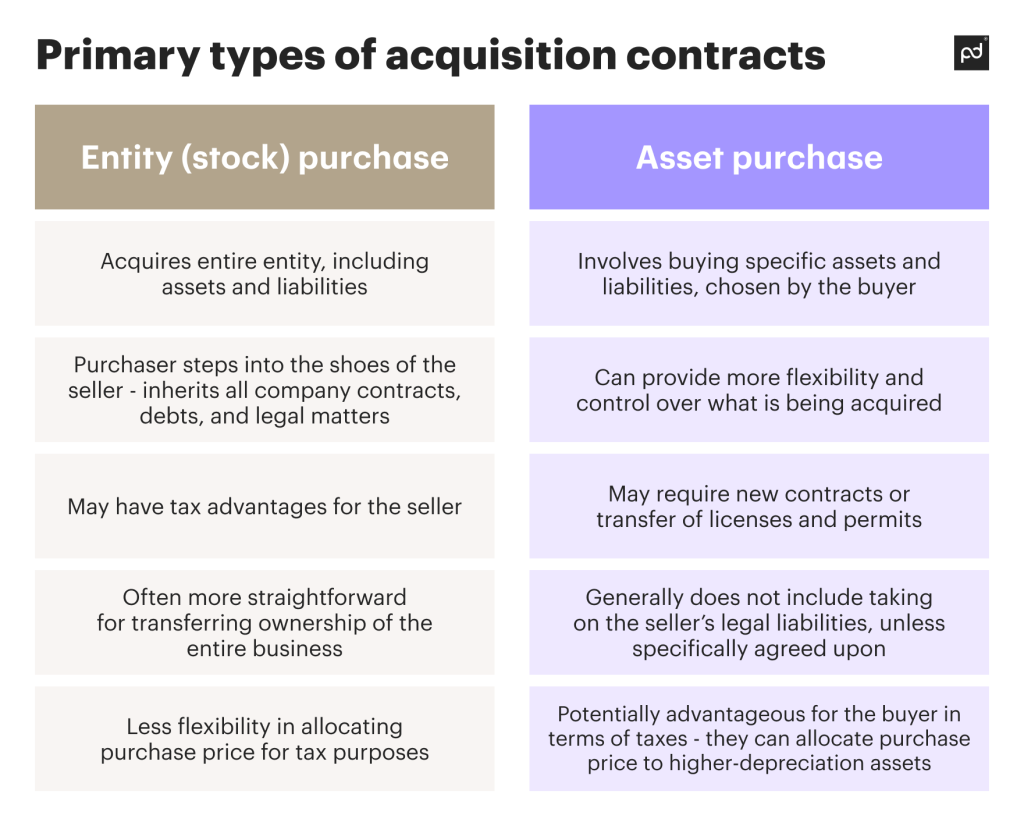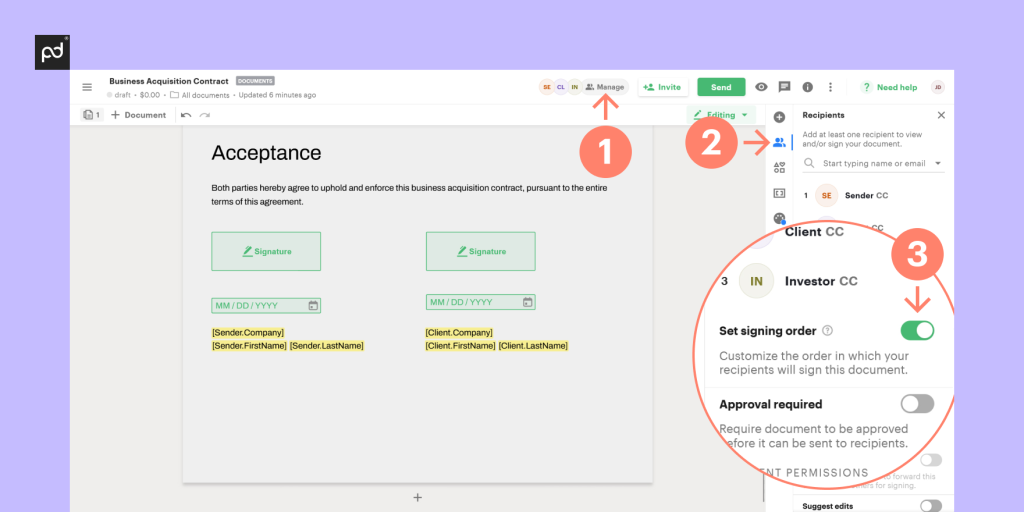An acquisition contract is a legal document that facilitates the buying of one company by another.
This contract outlines the details of the deal, including the transaction description, guarantees and promises, conditions, commitments, provisions for ending the agreement, and clauses for compensation.
Read on to learn more about the specifics of acquisitions, what an acquisition agreement consists of, and how contract management software, virtual data rooms, and e-signature solutions can streamline your business contracting.
Key takeaways
- Entity purchase agreements and asset purchase agreements are two types of acquisition contracts that are different in terms of what is being acquired: entire ownership of an entity for the former; selective assets for the latter.
- Acquiring another business allows a buyer to rapidly grow their expertise, expand the portfolio, reduce competition, get a customer base, and establish a presence in a larger market;
- The process of drafting an acquisition agreement begins early in the stage of collecting documents that a buyer needs for an assessment.
- The contract lifecycle is a time-consuming process. This can be streamlined and shortened with features that contract management software provides, such as contract templates, collaboration, e-signatures, and signing orders.
What are the primary types of acquisition contracts
There are two main types of acquisition contracts.

In an entity purchase agreement, the buyer gains control by acquiring most or all of the company’s shares.
Once the transaction is complete, the original owner steps aside and the new team takes over.
This transfer of ownership includes not only the entity itself but also the company’s liabilities and debts.
In the meantime, the business typically continues to operate without significant interruption, as ownership of the entity only changes hands — management may be replaced in part or entirely, or may be asked to stay on.
Alternatively, an asset purchase agreement involves the buyer purchasing some or all assets of the company.
These can include everything from physical property to intangible property like trademarks and copyrights.
Here, the original owners maintain ownership of the corporate structure, but it effectively ceases to conduct any operational business.
The new management can renegotiate existing contracts with employees and clients, as well as to retitle certain assets.
| Entity (stock) purchase | Asset purchase |
|---|---|
| Acquires entire entity, including assets and liabilities | Involves buying specific assets and liabilities, chosen by the buyer |
| Purchaser steps into the shoes of the seller — inherits all company contracts, debts, and legal matters | Can provide more flexibility and control over what is being acquired |
| May have tax advantages for the seller | May require new contracts or transfer of licenses and permits |
| Often more straightforward for transferring ownership of the entire business | Generally does not include taking on the seller’s legal liabilities, unless specifically agreed upon |
| Less flexibility in allocating purchase price for tax purposes | Potentially advantageous for the buyer in terms of taxes — they can allocate purchase price to higher-depreciation assets |
How are mergers different from acquisitions
In a merger, two companies unite their resources and operations to form a new, single entity; in an acquisition, one company purchases another and gains control over it, integrating the acquired entity under the parent company’s legal name and structure.
Reasons for acquisitions
- Market expansion — to expand a business into a new geographical region or market, companies acquire existing businesses in that area, as they already have a customer base, brand name, personnel, and other assets
- Growth acceleration — acquiring a business is a way to increase your revenue and the size of your company quickly
- Acquiring technology or expertise — buying a company with a talented workforce and expertise allows a buyer to rapidly gain new capabilities and skills
- Reducing competition — when one company acquires another entity, the number of competitors decreases, while market dominance increases
- Diversification — a company acquires another business in a different industry or market to expand its portfolio, gain a new customer base, and add another revenue stream
- Economies of scale — when two companies combine their operations, this leads to sufficient cost reduction in production, distribution, and logistics
- Strategic realignment — an acquisition is a way to restructure a business strategy to adjust to new market trends and customer needs
What sections must be included in an acquisition contract
- Parties and recitals — an introductory paragraph, also known as a preamble, that introduces parties involved in a contract; it is followed by recitals, a narrative explaining the context and reasons for the acquisition
- Definitions — defined terms that most commonly appear in an agreement and help interpret various clauses
- Transaction structure — the way a transaction is carried out, either through an asset purchase or entity purchase
- Purchase price — outlines the amount the buyer needs to pay, the payment method, and the due date
- Representations and warranties — statements of fact and assurances made by the seller regarding the assets being sold, including their quality and nature
- Covenants — promises made by two parties to perform certain actions during the terms of an agreement, often written in non-compete or non-solicitation clauses
- Conditions — defined obligations of both parties that must be fulfilled to proceed to closure
- Termination — outlines conditions under which parties can terminate the contract, as well as the consequences of termination
- Indemnification — provisions where one party agrees to compensate the other for any loss or damage incurred as a result of a specific event or action
- Miscellaneous clauses — articles of the contract that cover important aspects of the agreement not part of the most common contract clauses
- Confidentiality agreement — outlined terms and conditions under which both parties agree to keep certain information confidential
- Dispute resolution — provisions that outline the process for resolving any disagreements or disputes that may arise between the parties
How to write a business acquisition contract
The process of drafting a business purchase agreement begins long before you put pen to paper.
1. Gather information and documents
Before entering into an agreement, a buyer assesses various aspects of a target company.
This stage is known as due diligence, during which a buyer requests and reviews documents and information related to the business.
Among the essential documents are:
- Financial statements — balance sheets, profit and loss statements, cash flow documents, and tax returns that signal the financial health of a business.
- Legal and organizational documents — articles of incorporation or formation, partnership agreements, business licenses, trademarks, and patents that reflect your compliance with laws and regulations.
- Business contracts – copies of contracts with clients and customers, supplier and vendor agreements, real estate leases, and employee contracts to help the buyer assess liabilities and ongoing obligations.
- Employee-related documents — organizational charts and job descriptions, employment contracts, performance evaluations, and payroll records to allow the buyer to understand your workforce better.
- Operational documents — standard operating procedures, quality control and safety procedures, equipment and inventory records to provide insights into your operations, processes, and systems.
This process of gathering documents is time-consuming and complex.
When it comes to storing these docs, you need a secure virtual place to keep sensitive and confidential information.
A virtual data room solution is one such option — it provides a digital space with advanced features like access control, document tracking, and version control, where different stakeholders can access and collaborate on docs if needed.
2. Draft the agreement
When drafting an agreement, focus on the must-have clauses mentioned above in this article.
Each section should be worded accurately and contain relevant information to your transaction.
Since a contract is reviewed by two parties, ensure everything is written in clear form with direct language — focused headings, bullet points, initialing tools, etc.
To streamline drafting an acquisition contract, consider using a free contract template, one that already contains the basic required information which you can adjust to match your transaction details.
3. Seek legal advice
When the draft is complete, ask a lawyer to review the agreement and any associated documents.
They will check for legal issues and liabilities, and suggest changes to make the agreement stronger.
When done manually, this process can take weeks or months to complete, depending on their workload and amount of docs.
A digital approach using contract management software is much more organized and streamlined.
This solution offers drafting, editing, and collaborating in one tool simultaneously, so you can easily work with a legal team to quickly solve issues.
Moreover, you can set up a signing order, so your document is sent to appropriate parties in a specific sequence.

4. Negotiate the contract with your buyer
Negotiation is where you discuss the terms and conditions of an agreement until they are beneficial for both parties.
To help yourself in this process, set negotiation goals beforehand to come to the desired outcomes.
Asking yourself questions like “Have I clearly explained the terms and conditions in the agreement?” or “Did I state the payment schedule, liabilities, and risks?” will help you align the doc with your interests.
When negotiating, practice active listening and patience.
Doing so will help you understand the intentions of another party and set the tempo of your discussions.
5. Sign the agreement
In order to bring an agreement to life, both parties need to sign the contract.
A modern approach to signing is to use electronic signature software.
It’s a secure and legally binding way to sign a contract digitally and from anywhere.
You can receive real-time updates the moment another party opens or signs a contract to stay in the loop of the latest status.
Effectively manage acquisition contracts with PandaDoc
Creating an acquisition contract involves careful planning, gathering as well as drafting necessary documents, and help from legal experts.
If not planned accurately, this process can take months. However, you can streamline the contract lifecycle by leveraging contract management software.
Disclaimer
PandaDoc is not a law firm, or a substitute for an attorney or law firm. This page is not intended to and does not provide legal advice. Should you have legal questions on the validity of e-signatures or digital signatures and the enforceability thereof, please consult with an attorney or law firm. Use of PandaDoc services are governed by our Terms of Use and Privacy Policy.


